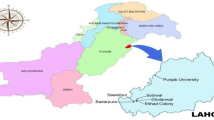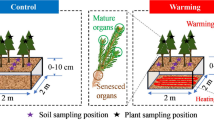Abstract
Bioindicators are useful in monitoring air pollution. This study assessed the efficacy of various tree leaf morphological, physiological and biochemical biomarkers in reflecting different intensities of air pollution. Leaves from Brachylaena discolor trees growing 0, 2.5, 6 and 11 km from an industrial hub (pollution source) in eThekwini, South Africa, were analysed for leaf area, chlorophyll (Chl) content, superoxide and hydrogen peroxide (H2O2) production, electrolyte leakage, total antioxidant activity and concentration of selected minerals. B. discolor saplings grown under greenhouse conditions served as an ex situ control. Surface SO2 and NOx levels which were measured at the in situ and control sites declined significantly with increasing distance from the source but were below detectable limits at the control site. At the site closest to the source, leaf area was significantly lower and Chl, electrolyte leakage, and copper (Cu) and phosphorous (P) levels were significantly higher than the control. Leaf area was significantly positively, and Chl content significantly negatively, correlated with distance from the source, while H2O2 production, electrolyte leakage and Cu and P concentrations were all significantly negatively correlated with distance from the source. The aforementioned parameters represent potential biomarkers of air pollution in B. discolor and in some cases (e.g., H2O2 and electrolyte leakage; leaf area and leaf Chl content) should be measured in conjunction with each other to accommodate for interactive effects. Using B. discolor leaves as bioindicators of air pollution may represent a more viable option for monitoring air pollution than monitoring stations.







Similar content being viewed by others
References
Arnon, D. I. (1949). Copper enzymes in isolated chloroplasts polyphenyloxidase in Beta vulgaris. Plant Physiology, 24, 1–15.
Assadi, A., Pirbalouti, A. G., Malekpoor, F., Teimori, N., & Assadi, L. (2011). Impact of air pollution on physiological and morphological characteristics of Eucalyptus camaldulensis Den. Journal of Food, Agriculture and Environment, 9, 676–679.
Bermudez, G. M., & Pignata, M. L. (2011). Antioxidant response of three Tillandsia species transplanted to urban, agricultural, and industrial areas. Archives of Environmental Contamination and Toxicology, 61, 401–413.
Boon, R. (2010). Pooley’s Trees of eastern South Africa. South Africa: Flora and Fauna Publications Trust.
Burton, A. J., Pregitzer, K. S., & Reed, D. D. (1991). Leaf area and foliar biomass relationships in northern hardwood forests located along an 800 km acid deposition gradient. Forest Sciences, 37, 1041–1059.
Bytnerowicz, A., Omasa, K., & Paoletti, E. (2007). Integrated effects of air pollution and climate change on forests: a northern hemisphere perspective. Environmental Pollution, 147, 438–445.
Carmichael, G. R., Ferm, M., Thongboonchoo, N., Woo, J., Chan, L. Y., Murano, K., Hung Viet, P., Mossberg, C., Bala, R., Boonjawat, J., Upatum, P., Mohan, M., Chen, T., Jie, T., Guoan, D., Peng, L. C., Dhiharto, S., Harjanto, H., Jose, A. M., Kimari, W., Kirouane, A., Lacaux, J. P., Richard, S., Barturen, O., Cerda, J. C., Athayde, A., Tavares, T., Cotrina, J. S., & Bilici, E. (2003). Measurements of sulfur dioxide, ozone, and ammonia concentrations in Asia, Africa, and South America using passive samplers. Atmospheric Environment, 37, 1293–1308.
Chapin, F. S. (1991). Integrated responses of plants to stress. BioScience, 41, 29–36.
Conti, M. E., & Cecchetti, G. (2001). Biological mointoring: lichens as bioindicators of air pollution assessment – a review. Environmental Pollution, 114, 471–492.
Diab, R., Prause, A., & Bencherif, H. (2002). Analysis of SO2 pollution in the south Durban industrial basin. South African Journal of Science, 98, 546–548.
Dineva, S. B. (2004). Comparative studies of the leaf morphology and structure of white ash Fraxinus americana L. and London plane tree Platanus acerifolia Willd growing in polluted area. Dendrobiology, 52, 3–8.
Doner, G., & Ege, A. (2004). Evaluation of digestion procedures for the determination of iron and zinc in biscuits by flame atomic absorption spectrometry. Analytica Chimica Acta, 520, 217–222.
Elstner, E. F., & Heupel, A. (1976). Inhibition of nitrite formation from hydroxylammoniumchloride: a simple assay for superoxide dismatase. Analytical Biochemistry, 70, 616–620.
Emberson, L. D., Ashmore, M. R., Murray, F., Kuylenstierna, J. C. I., Percy, K. E., Izuta, T., Zheng, Y., Shimizu, H., Sheu, B. H., Liu, C. P., Agrawal, M., Wahid, A., Abdel-Latif, N. M., van Tienhoven, M., de Bauer, L. I., & Domingos, M. (2001). Impacts of air pollutants on vegetation in developing countries. Water, Air, and Soil Pollution, 130, 107–118.
Emberson, L., Ashmore, M., & Murray, F. (2003). Air pollution impacts on crops and forests: a global assessment. Air Pollution Reviews, 4, 1–372.
Gill, S. S., & Tuteja, N. (2010). Reactive oxygen species and antioxidant machinery in abiotic stress tolerance in crop plants. Plant Physiology and Biochemistry, 48, 909–930.
Haglera, G. S. W., Bergina, M. H., Salmonc, L. G., Yud, J. Z., Wand, E. C. H., Zheng, M., Zenge, L. M., Kiange, C. S., Zhange, Y. H., Lauf, A. K. H., & Schauer, J. J. (2006). Source areas and chemical composition of fine particulate matter in the Pearl River Delta region of China. Atmospheric Environment, 40, 3802–3815.
Hayes, F., Wagg, S., Mills, G., Wilkinson, S., & Davies, W. (2012). Ozone effect in a drier climate: implications for stomatal fluxes of reduced stomatal sensitivity to soil drying in a typical grassland species. Global Change Biology, 18, 948–959.
Hung, K. T., Cheng, D. G., Hsu, Y. T., & Kao, G. H. (2008). Abscisic acid-induced hydrogen peroxide is required for anthocyanin accumulation in leaves of rice seedlings. Journal of Plant Physiology, 165, 1280–1287.
Jana, S., & Choudhuri, M. A. (1981). Glycolate metabolism of three submersed aquatic angiosperms: effect of heavy metals. Aquatic Botany, 11, 67–77.
Josipovic, M., Annegarn, H. J., Kneen, M. A., Pienaar, J. J., & Piketh, S. J. (2010). Concentrations, distributions and critical level exceedance assessment of SO2, NO2 and O3 in South Africa. Environmental Monitoring and Assessment, 171, 181–196.
Li, L., & Yi, H. (2012). Effect of sulfur dioxide on ROS production, gene expression and antioxidant enzyme activity in Arabidopsis plants. Plant Physiology and Biochemistry, 58, 46–53.
Madejon, P., Maranon, T., Murillo, J. M., & Robinson, B. (2004). White poplar (Populus alba) as a biomonitor of trace elements in contaminated riparian forests. Environmental Pollution, 132, 145–155.
Manning, W. J., Godzik, B., & Musselman, R. (2002). Potential bioindicator plant species for ambient ozone in forested mountain areas of central Europe. Environmental Pollution, 119, 283–290.
Mičieta, K., & Murín, G. (1998). Three species of genus Pinus suitable as bioindicators of polluted environment. Water, Air, and Soil Pollution, 104, 413–422.
Minibayeva, F., Kolesnikov, O., Chasov, A., Beckett, R. P., Lüthje, S., Vylegzhanina, N., Buck, F., & Böttger, M. (2009). Wound‐induced apoplastic peroxidase activities: their roles in the production and detoxification of reactive oxygen species. Plant, Cell & Environment, 32, 497–508.
Minibayeva, F., Dmitrieva, S., Ponomareva, A., & Ryabovol, V. (2012). Oxidative stress-induced autophagy in plants: the role of mitochondria. Plant Physiology and Biochemistry, 59, 11–19.
Moraes, R. M., Klumpp, A., Furlan, C. M., Klumpp, G., Domingos, M., Rinaldi, M. C. S., & Modesto, I. F. (2002). Tropical fruit trees as bioindicators of industrial air pollution in southeast Brazil. Environment International, 28, 367–374.
Nagajyoti, P. C., Lee, K. D., & Sreekanth, T. V. M. (2010). Heavy metals, occurrence and toxicity for plants: a review. Environmental Chemistry Letters, 8, 199–216.
Novak, K., Skelly, J. M., Schaub, M., Kräuchi, N., Hug, C., Landolt, W., & Bleuler, P. (2003). Ozone air pollution and foliar injury development on native plants of Switzerland. Environmental Pollution, 125, 41–52.
Oksanen, E., Pandey, V., Pandey, A. K., Keski-Saari, S., Kontunen-Soppela, S., & Sharma, C. (2013). Impacts of increasing ozone on Indian plants. Environmental Pollution, 177, 189–200.
Rai, R., Rajput, M., Agrawal, M., & Agrawal, S. B. (2011). Gaseous air pollutants: a review on current and future trends of emissions and impact on agriculture. Journal of Scientific Research, 55, 77–102.
Ramanathan, V., & Feng, Y. (2009). Air pollution, greenhouse gases and climate change: global and regional perspectives. Atmospheric Environment, 43, 37–50.
Re, R., Pellegrini, N., Proteggente, A., Pannala, A., Yang, M., & Andrice-Evans, C. (1999). Antioxidant activity applying an improved ABTS radical cation decolorization assay. Free Radical Biology and Medicine, 26, 1231–1237.
Rodriguez-Amaya, D. B., & Kimura, M. (2004). HarvestPlus handbook for carotenoid analysis. Washington: International Food Policy Research Institute (IFPRI).
Santamaría, J. M., & Martín, A. (1997). Tree bark as a bioindicator of air pollution in Navarra, Spain. Water, Air, and Soil Pollution, 93, 381–387.
Seyyednejad, S. M., & Koochak, H. (2011). A study on air pollution effects on Eucalyptus camaldulensis. International Conference on Environmental Biomedical and Biotechnology, 16, 98–101.
Soon, Y. K., Kalra, Y. P., & Abboud, S. A. (1996). Comparison of some methods for the determination of total sulphur in plant tissues. Communications in Soil Science and Plant Analysis, 27, 809–818.
Suzuki, K., Yabuki, T., & Ono, Y. (2009). Roadside Rhodoendron pulchrum leaves as bioindicators of heavy metal pollution in traffic areas of Okayama, Japan. Environment Monitoring Assessment, 149, 133–141.
Swart, R., Amann, M., Raes, F., & Tuinstra, W. (2004). A good climate for clean air: linkages between climate change and air pollution. An editorial essay. Climatic Change, 66, 263–269.
Taiz, L., & Zeiger, E. (1998). Plant physiology (2nd ed.). Sunderland: Sinauer Assosiates, Inc.
Tanee, F. B. G., & Albert, E. (2013). Air pollution tolerance indices of plants growing around Umuebulu gas flare station in Rivers State, Nigeria. African Journal of Environmental Science and Technology, 7, 1–8.
Taylor, G. E., Johnson, D. W., & Andersen, C. P. (1994). Air pollution and forest ecosystem: a regional to global perspective. Ecological Applications, 4, 662–689.
Thomas, M. D. (1961). Effects of air pollution on plants. Monograph Series. World Health Organization, 46, 233–278.
Tiwari, S., Agrawal, M., & Marshall, F. M. (2006). Evaluation of ambient air pollution impact on carrot plants at a suburban site using open top chambers. Environmental Monitoring and Assessment, 119, 15–30.
Tripathi, A. K., & Gautam, M. (2007). Biochemical parameters of plants as indicators of air pollution. Journal of Environmental Biology, 28, 127–132.
Tyson, P.D., Kruger, F.J., Louw, C.W. (1988). Atmospheric pollution and its implications in the Eastern Transvaal Highveld. National Scientific Programmes Unit: CSIR, SANSP Report, 150, 1–123.
Tzvetkova, N., & Kolarov, D. (1996). Effect of air pollution on carbohydrates and nutrients concentrations in some deciduous tree species. Bulgarian Journal of Plant Physiology, 22, 53–63.
Valavanidis, A., Vlahogianni, T., Dassenakis, M., & Scoullos, M. (2006). Molecular biomarkers of oxidative stress in aquatic organisms in relation to toxic environmental pollutants. Ectotoxicology and Environmental Safety, 64, 178–189.
Acknowledgments
Special thanks to the National Research Foundation of South Africa for the necessary funding, and the University of KwaZulu-Natal, South Africa, for providing the laboratory facilities and resources for this research. Thanks to Mr. Bongani Mdamba for the extra pair of hands. Heavenly Father this is for your glory.
Author information
Authors and Affiliations
Corresponding author
Rights and permissions
About this article
Cite this article
Areington, C.A., Varghese, B., Ramdhani, S. et al. An Assessment of Morphological, Physiological and Biochemical Biomarkers of Industrial Air Pollution in the Leaves of Brachylaena discolor . Water Air Soil Pollut 226, 291 (2015). https://doi.org/10.1007/s11270-015-2541-0
Received:
Accepted:
Published:
DOI: https://doi.org/10.1007/s11270-015-2541-0





